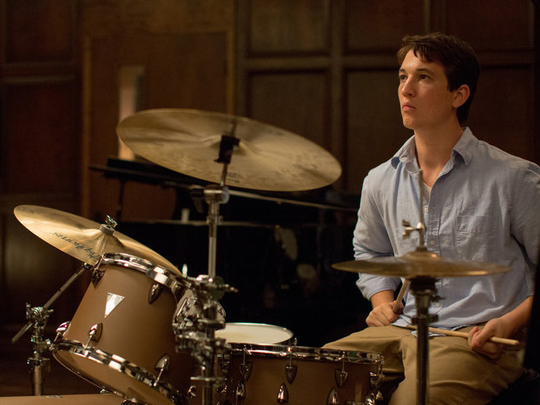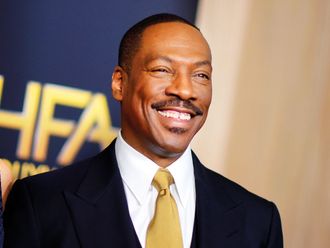
Nominated for five Academy Awards, Whiplash is about a jazz drummer who drums till his fingers bleed. His connection to the kit he pounds so obsessively is echoed by his abusive relationship with the conservatory conductor, who yells obscenities in his face like the drill sergeant from Full Metal Jacket. You could substitute another instrument, but it wouldn’t be the same, because drums are primal, physical, brutal in a way that other instruments are not. They signal war, sex and violence, life and death — sometimes all at once.
Drummers are a fundamental part of the team, yet detached, with their own special rules; the musician equivalent of goalkeepers. In films, drummers are often depicted as obsessives, non-conformists, or psychos.
Towards the end of Young and Innocent, in one of Alfred Hitchcock’s most celebrated early set-pieces (1937), plucky Nova Pilbeam is searching for a murder suspect who she knows has a twitch; the camera roams around the hotel ballroom before — of course! — finally closing in on the twitching eye of the blackface dance band’s drummer.
Another plucky dame, Ella Raines in Robert Siodmak’s smashing film noir Phantom Lady (1944), adapted from a Cornell Woolrich novel, searches for a missing witness whose testimony can save her boss from a death sentence. And succeeds in attracting the attention of a man who might know the witness’s whereabouts — jazz drummer Elisha Cook Jr, whose frenzied solo leaves one in little doubt as to what he expects from her. Cook’s drumming was actually dubbed by Dave Coleman.
But some well-known drummers did get to perform cameos as themselves. Gene Krupa (who dubbed Sal Mineo’s drumsticks in his own biopic, The Gene Krupa Story, does nifty matchbox percussion in a nightclub scene with Barbara Stanwyck in Ball of Fire, Howard Hawks’s delightful reworking of Snow White and the Seven Dwarfs, while Buddy Rich and Eleanor Powell share a breathtaking drum-related moment at the end of a dance number from Ship Ahoy! If they filmed that today, it would surely have to be with CGI.
More recently, John Bonham played himself, even in the fantasy sequences of The Song Remains the Same, where his Led Zeppelin bandmates fantasised about being knights or masked men. Ginger Baker was the irascible subject of Jay Bulger’s documentary Beware of Mr Baker, but in 1965 could also be seen thumping the tubs in the bonkers British sci-fi musical Gonks Go Beat.
Keith Moon, who when not throwing TV sets out of windows, popped up in several wacky movie cameos, had a brief but intense scene as Billy Fury’s drummer in That’ll Be the Day. More recently, MTV and Nickleodeon star Nick Cannon played the protagonist of Drumline: A New Beat, about a cocky Harlem street drummer who has to “learn to follow before you can lead” at a marching band university in Atlanta. The film sticks faithfully to the cliches of teen musicals and hip-hop musicals, ending with a showdown between rival bands, but stands out by virtue of its musical numbers, a rousing blend of classical, funk and rap, belted out with flamboyant Busby Berkley-esque choreography. You can see a genuine street drummer, Gene Palma, in situ on the streets of Seventies New York in Taxi Driver, when Travis Bickle is taking Betsy on a date to a porn cinema.
Drummers are outside society, like Jean Reno in Subway, or outsiders even within their own band, like the famous writer who agrees to play drums for a handicapped punk group called The Feminists in the Trainspotting-like Ex-Drummer, a wilfully non-PC slice of Flemish lowlife. Maybe because they lend themselves to slapstick, drums are also a favourite prop in comedies and cartoons; everyone’s favourite musical punchline is the rimshot. Drumming is something that comes naturally to babies, whether with fists or heels, and there’s nothing quite like a drumkit to signify arrested development, whether it’s Will Ferrell invading John C Riley’s space in Step Brothers or Judge Reinhold, who in Vice Versa (1988) swaps bodies with his 11-year-old son and starts slapping the skins in the department store where he works.
Drums are an obvious mode of expression for man-child Garth in Wayne’s World (“I like to play”). In The Rocker, Rainn Wilson ticks off every box on the mad drummer checklist (drunkenness, wanton destruction and childish rebellion) when, 20 years after being fired from his heavy metal rock group, he fills in on the skins in his nephew’s band, and ends up a YouTube phenomenon known as “The Naked Drummer”. Less comically, the drum in Volker Schlondorff’s The Tin Drum, adapted from Gunter Grass’s novel, is a symbol of young Oskar’s refusal to grow into an adult when Germany descends into Nazi madness, and the world around him is torn apart by war.
Drums are considered masculine territory, so if female characters play them, they are almost always depicted as tomboys, such as Mary Ellen Masterson in the John Hughes-scripted Some Kind of Wonderful, Alison Pill in Scott Pilgrim vs. The World, or Linda Manz, who gets to bash a drumkit at a Pointed Sticks gig in Dennis Hopper’s 1980 “comeback” film, Out of the Blue. They’re a long way from such ladylike real-life bucket-bangers as Honey Lantree of The Honeycombs, or Karen Carpenter, whose tragic life was captured most memorably in Todd Haynes’s Superstar: The Karen Carpenter Story, in which she and her brother were played by Ken and Barbie dolls. Drummers can provide a film with its heartbeat, but — like Pete Best or John “Stumpy” Pepys — they are easily replaced. Which is just as well, since they sometimes expire “in mysterious circumstances” as detailed in the definitive rock music movie, This Is Spinal Tap. “Dozens of people spontaneously combust each year. It’s just not widely reported.”
Whiplash releases in the UAE on February 19.










